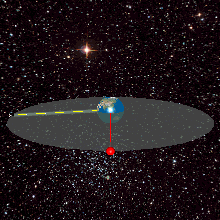|
Satellite Delay
Satellite delay is the noticeable latency due to the limited speed of light, when sending data to and from satellites, especially distant geosynchronous satellites. Bouncing a signal off a geosynchronous satellite takes about a quarter of a second, which is enough to be noticeable, but relaying data between two or three such satellites increases the delay. See also *Geosynchronous satellite A geosynchronous satellite is a satellite in geosynchronous orbit, with an orbital period the same as the Earth's rotation period. Such a satellite returns to the same position in the sky after each sidereal day, and over the course of a day tra ... References {{DEFAULTSORT:Satellite delay Engineering concepts ... [...More Info...] [...Related Items...] OR: [Wikipedia] [Google] [Baidu] |
Latency (engineering)
Latency, from a general point of view, is a time delay between the cause and the effect of some physical change in the system being observed. Lag, as it is known in gaming circles, refers to the latency between the input to a simulation and the visual or auditory response, often occurring because of network delay in online games. Latency is physically a consequence of the limited velocity at which any physical interaction can propagate. The magnitude of this velocity is always less than or equal to the speed of light. Therefore, every physical system with any physical separation (distance) between cause and effect will experience some sort of latency, regardless of the nature of the stimulation at which it has been exposed to. The precise definition of latency depends on the system being observed or the nature of the simulation. In communications, the lower limit of latency is determined by the medium being used to transfer information. In reliable two-way communication ... [...More Info...] [...Related Items...] OR: [Wikipedia] [Google] [Baidu] |
Speed Of Light
The speed of light in vacuum, commonly denoted , is a universal physical constant that is important in many areas of physics. The speed of light is exactly equal to ). According to the special theory of relativity, is the upper limit for the speed at which conventional matter or energy (and thus any signal carrying information) can travel through space. All forms of electromagnetic radiation, including visible light, travel at the speed of light. For many practical purposes, light and other electromagnetic waves will appear to propagate instantaneously, but for long distances and very sensitive measurements, their finite speed has noticeable effects. Starlight viewed on Earth left the stars many years ago, allowing humans to study the history of the universe by viewing distant objects. When communicating with distant space probes, it can take minutes to hours for signals to travel from Earth to the spacecraft and vice versa. In computing, the speed of light fixes the ... [...More Info...] [...Related Items...] OR: [Wikipedia] [Google] [Baidu] |
Geosynchronous Satellite
A geosynchronous satellite is a satellite in geosynchronous orbit, with an orbital period the same as the Earth's rotation period. Such a satellite returns to the same position in the sky after each sidereal day, and over the course of a day traces out a path in the sky that is typically some form of analemma. A special case of geosynchronous satellite is the geostationary satellite, which has a geostationary orbit – a circular geosynchronous orbit directly above the Earth's equator. Another type of geosynchronous orbit used by satellites is the Tundra elliptical orbit. Geostationary satellites have the unique property of remaining permanently fixed in exactly the same position in the sky as viewed from any fixed location on Earth, meaning that ground-based antennas do not need to track them but can remain fixed in one direction. Such satellites are often used for communication purposes; a geosynchronous network is a communication network based on communication with or thro ... [...More Info...] [...Related Items...] OR: [Wikipedia] [Google] [Baidu] |
Geosynchronous Satellite
A geosynchronous satellite is a satellite in geosynchronous orbit, with an orbital period the same as the Earth's rotation period. Such a satellite returns to the same position in the sky after each sidereal day, and over the course of a day traces out a path in the sky that is typically some form of analemma. A special case of geosynchronous satellite is the geostationary satellite, which has a geostationary orbit – a circular geosynchronous orbit directly above the Earth's equator. Another type of geosynchronous orbit used by satellites is the Tundra elliptical orbit. Geostationary satellites have the unique property of remaining permanently fixed in exactly the same position in the sky as viewed from any fixed location on Earth, meaning that ground-based antennas do not need to track them but can remain fixed in one direction. Such satellites are often used for communication purposes; a geosynchronous network is a communication network based on communication with or thro ... [...More Info...] [...Related Items...] OR: [Wikipedia] [Google] [Baidu] |


